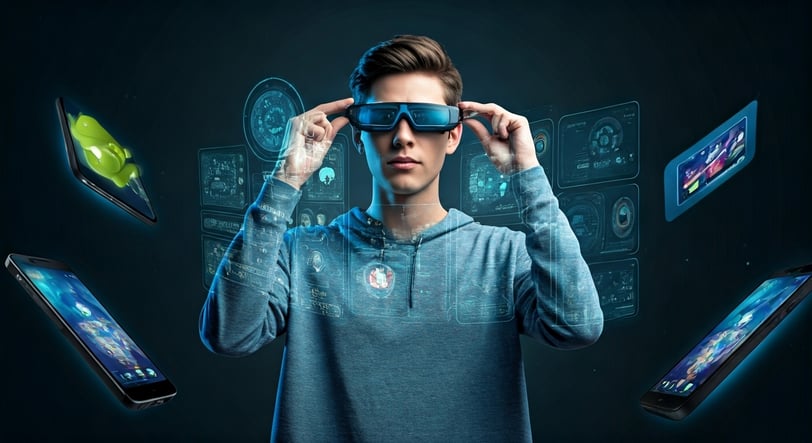
Developing Mobile Apps for Android XR & Smart Glasses
Android XR is the next big thing in immersive tech. It mixes the newest systems with smart glasses and other extended reality (XR) devices. This platform works with the Android world. It helps developers make xr apps that work well and are ready for real life. These xr apps fit both augmented reality and virtual reality needs. With cool tools like Google’s Gemini AI and the Android SDK, xr apps on Android XR can change how we see things in areas like education, healthcare, and how things are made. Let’s look at how to make mobile xr apps for Android XR and smart glasses.
MOBILE APP DEVELOPMENT
Key Highlights
Android XR provides developers with an open-standard platform to create innovative XR apps compatible with various smart glasses and headsets, including Samsung’s Project Moohan and eyewear by Gentle Monster and Warby Parker.
Seamless integration of augmented reality (AR) and virtual reality (VR) features allows immersive experiences in real-world and digital environments.
SDKs like Unity OpenXR and Android XR SDK simplify the app development process for smart glasses and XR headsets.
Gesture, hand tracking, and Gemini voice commands are central to intuitive app functionality, enhancing spatial computing capabilities.
With its modular design and scalable ecosystem, Google’s Android XR simplifies deployment and future upgrades across multiple devices.
Introduction
Android XR is the next big thing in immersive tech. It mixes the newest systems with smart glasses and other extended reality (XR) devices. This platform works with the Android world. It helps developers make xr apps that work well and are ready for real life. These xr apps fit both augmented reality and virtual reality needs. With cool tools like Google’s Gemini AI and the Android SDK, xr apps on Android XR can change how we see things in areas like education, healthcare, and how things are made. Let’s look at how to make mobile xr apps for Android XR and smart glasses.
Essential Steps for Developing Mobile Apps for Android XR & Smart Glasses
Building mobile apps for android xr and smart glasses needs you to have the right technical skills and a clear plan. The first thing to do is to get to know the android xr world and stay up to date with new things like stylish glasses and other mixed reality devices. You have to pick the best tools, like android xr sdk, to make xr apps that work well and can grow as more people use them.
You should think about the way people will use your apps. This means making user interfaces that pull people into your app, using spatial panels, and adding fun ways to control things, like gesture controls. When you make sure your apps run well and also give new xr features, your apps can do well on smart glasses and other devices.
1. Understanding the Android XR & Smart Glasses Ecosystem
The android xr ecosystem is changing the way people think about smart glasses. These glasses now have more advanced features and can work with different kinds of technology. Samsung’s project moohan and eyewear brands like Gentle Monster and Warby Parker are working together with Google to make smart glasses powered by android xr. The glasses use AR features, so you can see things like arrows for directions right on top of the real world in google maps.
Google is working on making stylish glasses that are about more than just looks. With things like gemini voice commands powered by AI, built-in cameras, microphones, and displays inside the lens, you get an easy way to interact with the digital world. Useful apps such as google translate and calendar are being made to fit right into these glasses, helping you do normal tasks in new and immersive ways.
The focus is not just on style. The android xr ecosystem is made to be modular. This means developers can create xr apps that work with many types of eyewear brands and on different systems. It supports ideas from many people, turning android xr into a strong base for innovation in XR. Google’s support for open standards helps developers and makes it easier for businesses to grow and use these tools.
2. Selecting the Right Hardware and SDKs
Choosing the right hardware and SDKs is key when you want to make XR apps for smart glasses. In the android xr world, Samsung’s Project Moohan headset is a big name. Warby Parker and Gentle Monster also make smart glasses that many people use. These smart glasses have good designs and built-in AI systems like Gemini. They offer users comfort and smarter ways to use their devices.
Picking the right SDK can help make your work easier. It lets your xr apps work well on xr headsets and smart glasses. Using flexible tools like Unity makes sure you use spatial computing in your apps. This way, you can make the user experience on different smart glasses even better. You should always match your SDKs and hardware with your target use cases to get the best results for both performance and how people interact with the apps.
3. Designing Immersive User Interfaces for XR Environments
Creating engaging XR apps starts with making user interfaces that feel real and pull people in. The interfaces should work well for both real world use and virtual spaces. When using spatial computing, you design spatial panels that help XR content look its best.
For XR apps to be simple and easy to use:
Use Material Design. This keeps things clear and helps lay out spatial panels in a neat way.
Try Jetpack Compose. It lets the user interface change as needed and keeps updates fast on the screen.
Make sure content overlays work in real time. It should always be easy for people to see and use, no matter where they are in the virtual world.
These ideas help XR apps work well everywhere, whether on headsets or smart glasses. Developers should put user interaction first. That means using easy gestures and voice commands, and following ergonomic tips. Putting in fun 3D models also makes people enjoy the XR apps more. At the same time, always keep digital overlays simple and clear.
With smart glasses, xr apps, spatial computing, spatial panels, material design, and jetpack compose, it will be simple to make great experiences that people want to use.
4. Implementing Gesture and Voice Controls
Gesture and voice controls play a key role in making Android XR apps easy to use. The use of hand tracking, which allows for the move of 26 hand joints, helps developers give users smooth control in the app.
Here are some helpful tips for XR apps:
Gemini Voice Commands: Let people control content with their voice, which helps users do more than one thing at a time.
Precise Hand Tracking: Make sure people can use their hands in space for moving around the app or doing actions.
Refined User Flow: Try to move away from menu-heavy navigation and focus on natural ways to use the app.
Android Studio helps quickly set up gestures in android xr apps, and Gemini AI makes the use of voice commands easy. This supports designs that are simple and user-friendly. By adding different ways to control the app, such as voice and hand tracking, android xr apps can be used with no touch at all, which makes users happier. Testing the app well helps it run better, so gestures and commands work right every time.
5. Optimizing Performance for Wearable Hardware
Making your Android XR apps work well on smart glasses and other wearable devices helps save power and get people more involved. XR headsets and other android xr devices need good performance, even with things like lower battery life and less processing strength.
To help your xr apps run better:
Try to lower how much the app uses the power and memory during real-time use. Find the right mix so it works well but does not use too much power.
Change how sharp the graphics look and set dynamic refresh rates. This keeps Android XR experiences running smoothly on android phones and smart glasses.
With tools built into the system, you can check how your android xr apps might push parts of smart glasses or other xr headsets too hard. Making sure the apps work well with different ways to give inputs makes it perform better, whether people use wearables, do real-world tasks, or move into virtual spaces.
6. Integrating Augmented Reality (AR) and Virtual Reality (VR) Features
Adding augmented reality (AR) and virtual reality (VR) to android xr apps makes the user experience much better. When you use android xr sdk and unity openxr, it lets you create new xr apps that mix digital and real world things. Features like hand tracking and spatial computing help people interact with ar glasses and vr headsets in a simple way. This brings many use cases to android xr and shows the power of xr apps for daily needs. By using jetpack xr plus strong material design, android xr developers can build high quality apps. This is a good way to make sure that new ideas for android xr apps fit well in the growing real world ecosystem.
7. Ensuring Security and Privacy for XR Applications
Security and privacy are very important when people make android xr apps. Gemini AI and MDM work together to help keep sensitive XR data safe. This gives users steady protection at all times.
Android xr lets you keep data safe through encryption in the XR world. At the same time, it helps follow all approved device rules. Security features such as special access checks and Play Protect help both companies and regular people trust these apps. Developers also use Android studio tools to watch for any weak spots in the app. They get to fix problems fast with update steps.
Strong XR security helps the user experience by keeping things safe and easy to use. At the same time, it shows that developers care about data privacy. Apps that respect privacy are more likely to be used in both work settings and by everyday people. This also lowers their risk.
8. Testing and Debugging on Real Devices
Testing XR apps using reference hardware and real devices is a key part of making a good app. Android XR emulators help by acting like the real hardware, so you can spot problems early and fix them before launch.
Complete device testing cycles:
Carry out stability checks on smart glasses and XR headsets.
Use Android XR Developer Preview tools to help with 3D debugging and system setup.
Get feedback from people using the apps in the real world, and change your apps based on that feedback.
When you test xr apps on many different devices, you help make sure they work across mixed reality systems. Keep notes on your tests. This makes it easier to update and roll out better versions of your android xr apps in the future.
9. Deploying and Updating Apps on the Google Play Store
The Google Play Store helps developers share XR apps with users. You can reach people on smart glasses and android xr headsets in a few simple steps. Make sure you follow the Play Console rules so people can get your xr apps on their android phones and vr systems.
Steps to optimise app lifecycle:
Change your apps to support Gemini voice and multimodal controls. This helps more people use them.
Try out android xr developer preview features to add support for xr-specific displays.
Keep apps fresh by using Play Console Insights. This lets you see how your xr apps really work out in the world.
When you keep adding new tools and updates, your android xr apps get better and more people keep using them. It is a good way to meet new xr market needs using the google play store for android xr, smart glasses, and android xr headsets.
Key Challenges in Android XR & Smart Glasses App Development
Developers working with android xr and smart glasses run into a number of problems. There are many kinds of hardware, like mixed reality headsets and other wearable gadgets. This means they have to be sure everything works well together. Device changes can give them a hard time while making things fit in.
Also, android xr technology must be set up just right so that it does not use up too much power or slow down. Many of these devices, like smart glasses, are small and light. They cannot hold strong processors like bigger computers. So, developers need to be smart about how they use power and resources.
Working with android xr means developers must learn how to deal with different hardware, handle power use, and make user features better. There is a real need to come up with new, better ways to build xr solutions so they work for everyone and can grow as more people use them.
Addressing Device Fragmentation and Compatibility Issues
Device fragmentation is still a big issue because Android XR-enabled hardware has many different specs. Developers need to make sure that apps work on a lot of devices, like XR headsets, AR glasses, and other wearable gadgets.
Key strategies include:
Using open standards like OpenXR to help your app work everywhere in a simple, universal way.
Doing lots of tough testing with Android XR emulators and XR Preview tools across all types of devices.
Working on scaling methods to keep app performance on the same level from one device to another.
Having good solutions for device compatibility makes it easy for people to use their apps on many types of hardware. This helps users have a smooth and enjoyable time on all kinds of Android XR gadgets, like AR glasses and XR headsets.
Handling Limited Battery Life and Processing Power
Smart glasses and other wearables can have problems with battery life and low processing power. Developers can help by making sure xr apps run well for a long time, especially on lightweight android xr devices.
You can use modular tools like android xr sdk to help these devices use less energy but still get the job done. Also, using Gemini-powered processing helps by cutting out extra work, making xr apps run smoother in real time. When developers find the right balance, they can make android xr headsets and great glasses more efficient and easy to use.
Conclusion
To sum up, making mobile apps for Android XR and smart glasses can be hard, but it is also very rewarding. This technology is growing fast, and it is important to know the android xr ecosystem, pick the right devices, and make a good user experience. You need to face problems like dealing with many different devices and make sure your app works well on wearable hardware. Solving these issues will help users have a better time. If you focus on new design ideas and strong features, you can build apps that users want. You will also help move ahead in virtual reality and smart glasses. If you want to make your app even better, get in touch with us now!
Frequently Asked Questions
What programming languages are best for Android XR app development?
Languages like JavaScript, C#, and Kotlin are good for android app development on XR platforms. You can use tools such as Unity OpenXR, Android Studio, and Jetpack XR to do your work. These tools help you make great apps that work on ar glasses and smart headsets. They give you the freedom to build for more than one platform and let you use cool design features. With these, people can make android apps that fit well with new tech and be ready for the future.
How do I test my app on different smart glasses models?
Testing XR apps means you have to use the Android XR emulator along with real hardware made for certain smart glasses models. When you debug, make sure you test on real devices, too. Check that your app works well across all the different XR devices and their specifications. This way, you know your XR apps will run smoothly on many smart glasses in different situations.
What are the main differences between AR and VR on Android?
AR adds digital things on top of what you see in the real world, while VR puts you into a whole new digital place by using VR headsets. In android xr, apps use ar glasses to work with spatial computing and use VR headsets to let you enter big virtual worlds. This all comes together to help android xr fit well in the broader extended reality space.
Are there any accessibility guidelines for XR applications?
Accessibility for XR apps means making sure they follow Material Design rules. This helps people use them easily. Good design offers simple and comfortable spatial computing layouts. The way people interact with the app should be quick and clear. Developers need to focus on making the user interface of android xr apps easy for all. They should also make sure it works well on any device that runs android xr. This gives all people a good experience.



